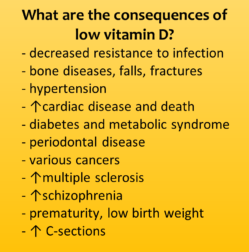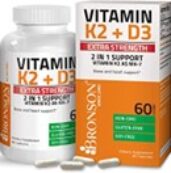
Greetings,
After my last newsletter about vitamin D, many of you contacted me questioning how much to take. Some people told me they were taking 2,000 IU per day; some said something like 1,000 IU two or three times a week.
That is nowhere near enough, unless you are getting adequate sunlight. Then the dosages above may be okay.
But many people work indoors or think they need to wear sunscreen or cover up with long clothing and a hat. If you have dark skin, you need more time in the sun to make the same amount of vitamin D as a light-skinned person. If you are overweight, you need more time in the sun to produce the same amount of vitamin D as a thinner person. The bottom line: Vitamin D deficiency has long been recognized as an epidemic in the United States and frankly, the majority of the world’s population has inadequate vitamin D status. Is it COVID, the flu, or RSV? Well, they all are respiratory infections, both have a similar list of symptoms, and both are treated about the same way. We usually can get the medications to you within 24 hours after you call us.
So, we’ve heard about vitamin D for our bones, and now for our immune system. But it’s way more than that. In the absence of vitamin D, not one of our body systems works well. D is one of several micronutrient co-factors needed for cell function. Inadequate vitamin D levels have many consequences.
How can it be that a single nutrient has effects in all of these different areas of the body? The reason is that vitamin D speaks to our DNA to determine what the cells need to make. When there’s not enough vitamin D present, you have various kinds of tissue breakdown. Consequently, disease results.

So, what is needed to get vitamin D levels into the optimal range sooner rather than later?
Sunlight: The dminder app is a great way to track how time in the sun translates into a “dose” of D. For many people, being out in the sun for about 20 minutes (or until skin gets slightly pink) during the right time of day can get you about 20,000 IU of vitamin D.
Vitamin D supplements: I generally recommend people regularly take about 10,000 IU with vitamin K2 per day. That will usually keep their levels in the optimal range. The really good news is that vitamin D pills are readily available. Bronson makes a vitamin D3 with 10,000 IU and K2-MK7 with 120 mcg per capsule. It can be purchased from Amazon. The experts suggest 90-125 mcg of K2-MK7 per day, not higher.

By the way, the United States has long used the measurement of IU, international units. Europe used micrograms, mcg. Since 2016, thanks to the FDA, we’re now seeing mcg in the United States. Many companies post both measurements since Americans are much more familiar with the IU approach. So… 10,000 IU of vitamin D = 250 mcg.
The optimal range for the blood serum level of vitamin D in the USA is a range, from 45-80 ng/ml. According to expert Robert Heaney, MD, FASN, levels of 60-80 ng/ml are common in outdoor summer workers. If you get slightly higher than that, that’s okay too.
When I started testing all of my patients for vitamin D, everyone was either low or sub-optimal. The RDA recommendation was 400 IU per day. It clearly was not enough. Even 5,000 IU didn’t raise their level to that optimal range. It generally takes a big “loading dose” to get into the optimal range, then taking 5,000 to 10,000 IU per day to stay in range. In today’s American culture, people generally need that much.
So, exactly how do you get from low to good numbers?
Experts agree you need a high loading dose to get to those good numbers because it could take many weeks – even months – to achieve optimal levels if just taking the lower maintenance dose. You need to start out with a bang. For example, FLCCC recommends that a 160-pound person take a first day dose of 300,000 IUs (7,500 mcg). We call that the loading dose. Then drop down to a lower amount the second day and thereafter.
I have seen several different protocols for that first day loading dose. The range is anywhere from 100,000 to 250,000 followed by a maintenance dose of around 5,000-10,000 IU/day.
The following is translated from the FLCCC.net protocols:

5,000-10,000 IUs per day is considered the Tolerable Upper Intake Level (TUIL) – the amount a healthy person can continue to take throughout life without any risk of adverse consequences. Vitamin D toxicity is virtually unheard of.
If you had a vitamin D test done and your number is less than 45, the FLCCC has several tables that describe this and you can check their suggestions, but they are complicated. https://covid19criticalcare.com/treatment-protocols/i-prevent-protect/
Here’s another very important thing to know about vitamin D and COVID: SARS-CoV-2 depletes vitamin D. Studies clearly show that the more vitamin D you have on board, the less severe your COVID infection is likely to be. That’s because D keeps the immune system working well. As vitamin D levels rise, immune cells are better able to chase after a virus without blowing up the body in the process – triggering that inflammatory cytokine storm that damages tissues and can lead to death.
Also, in people struggling with long COVID, we see a resurgence of latent viruses including herpes, CMV, parvovirus B19, and Epstein-Barr (EBV); 95% of the population is thought to carry a latent form of EBV. And get this: EVB also depletes vitamin D. So between the initial infection and the recurrence of latent viruses, our vitamin D levels plummet.

It’s pretty clear that vitamin D is important for preventing severe cases of infection and in overcoming long COVID.
How can we help you?
Dr. Linda Wright
Help us spread the word about Arizona Real Health by liking and sharing our social media pages with your friends and family!

Feel Free to Ask us Any Questions!
Dr. Linda Wright, Owner/Director
(602) 565-9273

